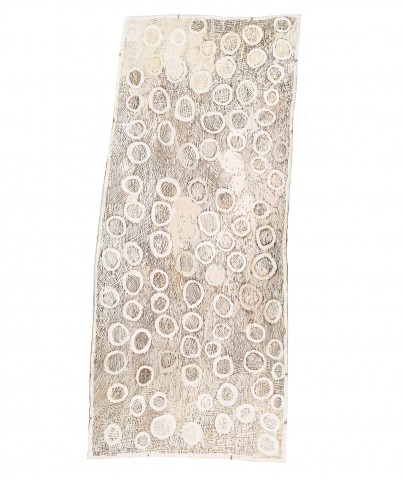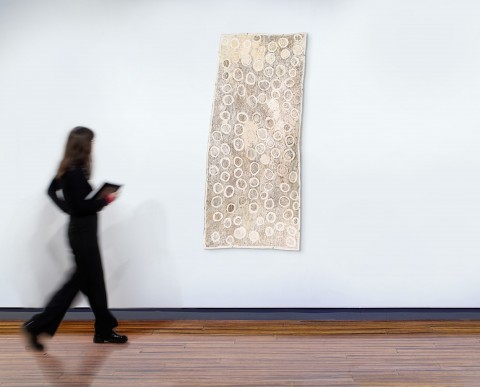CIRCLES, 2011
NYAPANYAPA YUNUPIŊU
natural earth pigments on eucalyptus bark
180.0 x 80.0 cm (irregular)
bears inscription verso: Buku-Larrŋgay Mulka Centre cat. 4039M
Buku Larrŋgay Mulka Centre, Yirrkala, Northern Territory (label attached verso)
Roslyn Oxley9 Gallery, Sydney (label attached verso)
Private collection, Sydney, acquired in 2011
Nyapanyapa Yunupiŋu, Birrka', Roslyn Oxley9 Gallery, Sydney, 6 – 29 October 2011, cat. 1
Working outside of previous Yolŋu conventions, the art of Nyapanyapa Yunupiŋu was unique and seemingly independent of Arnhem Land bark painting traditions. Valued for the spontaneity and texture of her hand and for the freeness of her mark making, she did not paint ancient dreaming narratives nor traditional clan designs like other Yolŋu artists; rather, her art is personal, recalling stories from her life or simply reflecting a spontaneous expression of the moment. ‘Yolŋu bark painting and sculpture traditionally conveys a temporal union between prehistory, the present and the distant future where all these time zones are happening simultaneously! This is the tense in which the creation events happened/are happening/will happen. All Yolngu art until this point was either sacred and in this tense or decorative. Decorative paintings were expressly ‘ordinary’ and without meaning or story of any kind.’1 However, once prompted in 2008 to paint the story of her almost fatal goring by a Buffalo that occurred in the 1970s, Nyapanyapa discarded these conventions and unleashed a unique set of personal narrative paintings revolving around her own experiences.2 Her early story paintings evolved quickly into an idiosyncratic method of mark making combining individual free flowing elements such as circles, squares and thick lines with underlying and rhythmic cross-hatching.
Circles, 2011 is one such work – here a loose and energetic surface of white circles hover above a base of dynamic patterned and variously hued crosshatching designs. Yunupingu’s paintings are rhythmic designs mapped out in bold gestures using traditional and non-traditional materials. The looseness of her hand and her particular focus upon form and line give her art a spontaneous quality, a contrast to the tightly geometric works of many contemporary Yirrkala artists. For as Luke Scholes reveals, ‘she painted for the pure, gleeful pleasure of it. There is no ego, no desire, she is instinctively and unreservedly giving herself to each mark.’3
1. Buku–Larrŋgay Mulka Centre certificate of authenticity
2. Will Stubbs, cited in Scholes, L., ‘Anyhow in the everywhen’ in Luke Scholes (ed.), The Moment Eternal, Nyapanyapa Yunupiŋu, Museum and Art Gallery of the Northern Territory, Darwin, 2020 p. 98
3. ibid p. 103
CRISPIN GUTTERIDGE

